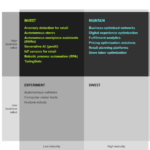Given the current rate of client conversion, less than 50% of ECC customers will have completed their transformation to S/4 by 2027. Further, about 13.000 ECC customers are on EhPs 0-5 with support only up to 2025 and calling for an even more urgent decision on the future of their ERP. Moreover, 90% of S/4 customers are running the first version they deployed on, and versions 1511, 1610, 1709, and 1809 are all out of support by now. Business demand for S/4 migrations is creating a bottleneck and an unavoidable skills shortage; according to the American SAP User Group (ASUG), 26% of organizations see skills in supporting, developing, and upgrading SAP systems as their number one challenge in working with the technology. Whatever stage you’re at with your migration planning, take these steps now if you haven’t already:
- Think of SAP as a cloud vendor. SAP has adjusted its commercial model to become a cloud business. Latest figures show more than 50% of the S/4HANA licenses sold in 2023 were via RISE. This is now the most common approach and a significant pivot for mature SAP ECC users. They will be procuring more from SAP and moving away from the on-prem world. There are accounting treatment changes to consider when you move from the on-prem world the licenses were bought and then capitalized to a subscription Opex model.
- Have a conversation with your database supplier to be certain of your deadline. S/4HANA only runs on an SAP database (HANA) and there’s no other way to run it. You can no longer select any other database. And just because you are on extended maintenance or customer-specific maintenance for ECC doesn’t mean that your database will get support. Some Oracle and IBM db2 (11.1, 10.5) versions will be going out of support already in 2025. There are some go-to releases like 19c for Oracle and 11.5 for db2 that should get support till 2027, but even those may move into extended maintenance before the 2027 deadline.
- Choose whether and how to RISE — or choose not to RISE. ECC and S/4HANA clients can decide to migrate to the cloud using the RISE program. Clients with SAP ERP can migrate to SAP S/4HANA Cloud Private Edition and preserve their existing configuration, customization, and historical data. S/4HANA customers can transition their SAP system as-is – from their data center to an SAP data center. While credits are available for new purchases of RISE with SAP signed before December 31, 2024, be aware that the financials may not be on your side when planning a migration. There are other considerations that you will have to make to justify this undertaking, from the availability of innovation to longer-term needs in terms of integration and new development.
- Decide which approach to take: hybrid/bluefield, greenfield, or brownfield. Choosing the approach is a key starting point for the migration. Customers running specific industry solutions sometimes go greenfield for lack of alternatives and clients wanting to go pure SaaS have no other option but greenfield. Clients wanting to consolidate and go from multiple ECC systems to one S/4 have to consider a hybrid/bluefield migration. The size of the HANA database will also influence your deployment decision; if you have lots of data in your SAP environment or you are bringing multiple ECC environments together, you do not want to pay a huge database bill for data you are not going to do anything with. And you may not want to migrate some data at all. If you’re in this boat, the hybrid option or the selective data transition will work better for you.
- Book your service provider ASAP. 30.000 ECC customers moving to S/4 by 2027 is going to create a bottleneck in the service provider space. Finding people and experts will be the greatest pain point. Major service providers do have programs in place to help with your migration. You can use The Forrester Wave™: SAP Implementation Services Partners, Q2 2022 to make a more informed decision.
Moving your current SAP ECC environment to the cloud can be a cumbersome undertaking but you can rely on our research. Whether it comes to Selecting Your Path To SAP In The Cloud or choosing a service provider for your migration, book a Guidance Session or an Inquiry with me to get started or to evaluate how your running migration is going.







